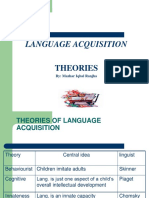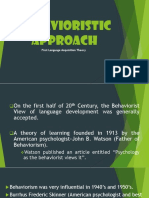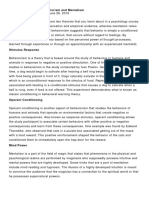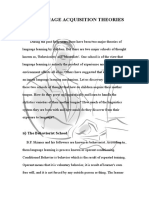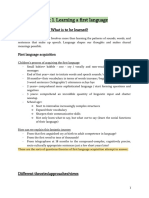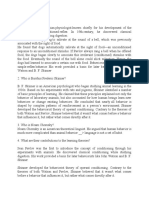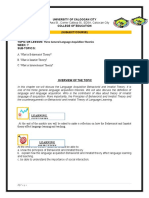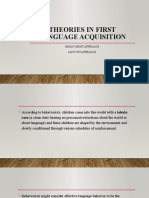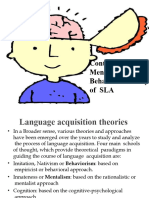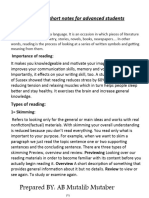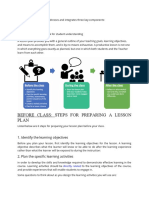[Psycholinguistics Notes]
[By Muhammad Usman]
1
�Origin and Development of
Psycholinguistics
What is Psycholinguistics?
Psycholinguistics is the study of how people
learn, understand, and use language. It
combines psychology (the study of the mind)
and linguistics (the study of language).
Origin of Psycholinguistics
Psycholinguistics began in the 1950s. Before
this, language was studied mainly through
grammar and structure. Wilhelm Wundt (late
1800s) believed that language and thought
were connected. In the early 20th century,
behaviorists like B.F. Skinner said that
language learning happens through imitation.
In 1957, Noam Chomsky disagreed and
introduced the idea of Universal Grammar,
saying that humans are born with an ability to
learn language.
Development of Psycholinguistics
2
�Psycholinguistics developed into different
areas:
Language Learning: Chomsky introduced the
Language Acquisition Device (LAD) to explain
how children learn language naturally.
Language Comprehension: The brain
processes words quickly and links them to
meaning.
Language Production: Speaking and writing
involve choosing words and forming
sentences.
Neurolinguistics: The brain controls language
through Broca’s Area (for speaking) and
Wernicke’s Area (for understanding). Brain
damage can cause aphasia (language loss).
Bilingualism: Learning more than one
language improves memory and thinking skills.
3
�Modern Psycholinguistics
Today, scientists use brain scans (fMRI, EEG)
to study how the brain processes language.
This helps in speech therapy, artificial
intelligence, and language teaching.
Stages in Language Acquisition
What is Language Acquisition?
Language acquisition is the process by which
humans learn to speak and understand a
language. It happens naturally, especially in
children, without direct teaching. According
to Noam Chomsky, humans are born with a
special ability to learn language.
Stage 1: Pre-Linguistic Stage (0-12 Months)
This is the stage before a child starts using
actual words. Babies make sounds like crying,
cooing, and babbling. Around 6 months, they
begin to repeat sounds like "ba-ba" or "da-
da." These sounds help them prepare for real
4
�words. They also start recognizing familiar
voices and tones.
Stage 2: One-Word Stage (12-18 Months)
At this stage, children start using single words
to express their needs and thoughts. These
words are often names of people, objects, or
actions, like "mama," "dada," "milk," or "go."
One word can have different meanings. For
example, a child saying "milk" could mean "I
want milk" or "This is milk."
Stage 3: Two-Word Stage (18-24 Months)
Children begin combining two words to form
simple sentences. They start saying phrases
like "want toy," "eat apple," or "go park."
Even though these sentences are short, they
show that the child understands how words
fit together.
Stage 4: Telegraphic Stage (2-3 Years)
5
�During this stage, children start forming
longer sentences, but they often leave out
small words like "is" or "the." Their sentences
sound like a telegram, which is why this stage
is called the telegraphic stage. For example,
they might say "want go park" instead of "I
want to go to the park."
Stage 5: Later Multi-Word Stage (3+ Years)
By this stage, children can form complete
sentences with correct grammar. They start
using more complex words, asking questions,
and telling short stories. Their vocabulary
grows quickly, and they begin to understand
and use grammar rules like verb tenses and
plurals.
Behaviorism Theory
Background of Behaviorism
Behaviorism is a learning theory that became
popular in the early 20th century. It was
developed as a reaction against the study of
6
�thoughts and emotions, which cannot be
directly observed. Behaviorists believe that
learning happens through experience, and
they focus only on actions that can be seen
and measured. According to behaviorism,
people learn language and other behaviors
through imitation, practice, rewards, and
punishments.
Main Features of Behaviorism
First, behaviorism focuses only on observable
behavior. It does not study thoughts or
emotions because they cannot be measured.
Second, it says that learning happens through
interaction with the environment. For
example, children learn words by listening to
others and copying them. Third, behaviorism
believes that reinforcement helps in learning.
If a child says a word correctly and gets a
reward, they will say it again. Fourth,
repetition and practice are important in
learning. The more a behavior is repeated, the
stronger it becomes.
7
�G.B. Watson’s Contributions
John B. Watson is known as the father of
behaviorism. He believed that all behavior is
learned from the environment. He rejected
the idea that thoughts and feelings play a role
in learning. He said that anyone can be
trained to behave in a certain way through
conditioning. Watson conducted the "Little
Albert Experiment", where he trained a baby
to fear white rats by making loud, scary noises
whenever the baby saw the rat. This
experiment showed that behavior can be
learned through association.
B.F. Skinner’s Contributions
B.F. Skinner expanded Watson’s ideas and
introduced Operant Conditioning, which
means that behavior is controlled by rewards
and punishments.
Stimulus is anything that causes a response.
For example, if a teacher asks a question, the
8
�student’s answer is a response to that
stimulus.
Reinforcement is anything that increases the
chance of a behavior happening again.
Positive reinforcement means giving a reward
for good behavior, like praising a child for
speaking correctly. Negative reinforcement
means removing something unpleasant to
encourage good behavior, like stopping a loud
noise when a child speaks correctly.
Punishment is anything that decreases the
chance of a behavior happening again.
Positive punishment means adding something
unpleasant, like scolding a child for making a
mistake. Negative punishment means taking
away something good, like not giving candy to
a child who misbehaves.
Limitations of Behaviorism
First, behaviorism does not explain complex
learning processes. It only focuses on simple
behaviors. Second, it ignores thoughts,
9
�emotions, and intelligence, which also play a
role in learning. Third, it does not explain how
people create new words and sentences that
they have never heard before. Fourth, it does
not consider the role of genetics in learning
and behavior.
Criticisms of Behaviorism
Noam Chomsky strongly criticized
behaviorism. First, he said that language
learning is not just about imitation and
rewards. Second, he argued that humans are
born with a natural ability to learn language.
Third, he introduced the idea of Universal
Grammar, which means all humans have a
basic understanding of language rules from
birth. Fourth, behaviorism only studies
external behavior and does not explain
internal mental processes like creativity and
problem-solving.
B.F. Skinner’s Experiment
10
�Skinner conducted an experiment using a
device called the "Skinner Box". He placed a
hungry rat inside a box with a lever. When the
rat pressed the lever, food was released. Over
time, the rat learned to press the lever
whenever it wanted food. This experiment
showed that behavior can be learned through
rewards and consequences.
Ivan Pavlov’s Experiment
Ivan Pavlov was a Russian scientist who
studied how animals learn. He conducted the
famous "Pavlov’s Dog Experiment". He rang a
bell before giving food to a dog. After several
repetitions, the dog began to salivate just by
hearing the bell, even when no food was
given. This showed that behavior can be
trained through association, which is called
Classical Conditioning.
Mentalism (Theory of Innatness)
by Noam Chomsky
Background of Mentalism (Innatness Theory)
11
�Mentalism, also known as the Innatness
Theory, was developed by Noam Chomsky as
a response to behaviorism. Behaviorists
believed that language is learned through
imitation and reinforcement. Chomsky
disagreed and argued that humans are born
with a natural ability to learn language. He
said that children do not only copy what they
hear but also create new sentences they have
never heard before. This means that the
ability to learn language is innate (already
present in the brain from birth).
Theory of Universal Grammar
Chomsky introduced the concept of Universal
Grammar (UG), which means that all human
languages share basic rules. He said that all
children are born with an understanding of
these rules. This is why children can learn any
language they are exposed to. Universal
Grammar explains why all languages have
common features like nouns, verbs, and
sentence structures.
12
�Theory of Transformational Generative
Grammar
Chomsky also introduced Transformational
Generative Grammar (TGG). This theory
explains how humans create new sentences
using grammar rules. It says that the brain has
a system that helps us transform simple
sentences into more complex ones. For
example, a child learns to change "She is
playing" into a question like "Is she playing?"
by following natural grammar rules.
Main Features of Mentalism
First, Chomsky said that humans are born
with a Language Acquisition Device (LAD),
which helps them learn language naturally.
Second, he introduced Universal Grammar
(UG), which means that all languages have
common rules. Third, he said that children
learn language quickly and easily, even
without formal teaching. Fourth, he believed
that the brain has a special ability to
13
�understand and use grammar, which makes
humans different from animals.
Limitations of Mentalism
First, the theory does not fully explain how
children learn different languages with
different grammar rules. Second, it does not
consider the role of social interaction in
language learning. Third, the idea of a
Language Acquisition Device (LAD) has no
clear scientific proof. Fourth, it does not
explain why some children struggle with
language learning even though they have the
same natural ability as others.
Criticisms of Mentalism
First, behaviorists criticize mentalism for
ignoring the role of experience and
environment in language learning. Second,
some researchers say that social interaction
and culture also influence language learning,
not just inborn ability. Third, neuroscientists
argue that there is no physical proof of the
14
�Language Acquisition Device (LAD) in the
brain. Fourth, some linguists believe that
Universal Grammar does not apply to all
languages because languages can be very
different from each other.
Socio-Cognitive Theory by Albert
Bandura
Background of Socio-Cognitive Theory
The Socio-Cognitive Theory was developed by
Albert Bandura in the 1960s. He disagreed
with behaviorists, who believed that learning
happens only through rewards and
punishments. Bandura said that people learn
by observing others, thinking, and interacting
with their environment. He introduced the
concept of "observational learning," which
means that people can learn new behaviors
by watching others. This theory combines
behavioral psychology (learning through
actions) and cognitive psychology (learning
through thinking).
15
�Elements of Learning
1. Environment
The environment plays an important role in
learning. A person learns by interacting with
people, situations, and surroundings. For
example, a child growing up in a bilingual
home learns two languages because of their
environment.
2. Cognition
Cognition refers to thinking and
understanding. People do not just copy
behavior but also process information in their
minds. For example, a student learning a new
language thinks about grammar rules and
meanings before speaking.
3. Behavior
Behavior is the action that a person performs
after learning. Learning changes how a person
acts. For example, after observing polite
16
�speech, a child starts using polite words like
"please" and "thank you."
4. Vicarious Learning
Vicarious learning means learning from others’
experiences. A person does not need to
experience something directly but can learn
by watching others. For example, a child
learns not to touch fire after seeing another
child get burned.
Stages of Learning
1. Attention
A person must focus on the behavior they
want to learn. Without attention, learning will
not happen. For example, a student must
listen carefully to the teacher to learn new
words.
2. Retention
17
�After observing a behavior, a person must
remember it. If they forget, they cannot use it
in the future. People remember actions by
creating mental images or repeating them in
their minds. For example, a student
remembers how a teacher pronounces words
and tries to copy them later.
3. Reproduction
A person must be able to copy or perform the
behavior they observed. This requires practice
and physical ability. For example, a child
learning to speak must practice pronouncing
words correctly.
4. Motivation
A person needs a reason to continue the
behavior. Motivation can come from rewards
(such as praise or success) or personal interest
(such as enjoyment or self-improvement). A
student who is praised for speaking well will
be motivated to keep improving.
18
�Self-Behavior Modification
1. Self-Observation
A person observes their own behavior and
identifies areas that need improvement. For
example, a student listens to their speech
recording to find mistakes.
2. Self-Judgment
A person compares their behavior with a
standard or goal. They decide if they are
performing well or need improvement. A
student may check if their pronunciation
matches their teacher’s pronunciation.
3. Self-Reaction
A person rewards themselves for success or
makes changes to improve. If they meet their
goal, they feel happy and motivated. If they
fail, they try a different approach. A student
may reward themselves with a break after
completing a language lesson.
19
�Steps of Self-Efficacy
1. Mastery Experience
A person gains confidence by successfully
completing a task. The more they succeed,
the more they believe in their abilities. A
student who successfully learns new words
feels confident in learning more.
2. Social Modeling
A person improves their confidence by
watching others succeed. Seeing someone
similar achieve a goal makes them believe
they can do it too. A student may feel
motivated to learn English after seeing a
friend speak fluently.
3. Social Persuasion
Encouragement from others helps a person
believe in themselves. Positive words from
teachers, friends, or family increase
20
�motivation. A teacher’s praise can help a
student feel more confident in speaking.
4. Emotional State
A person’s emotions affect their self-efficacy.
If they feel calm and positive, they believe
they can succeed. Stress and fear can lower
confidence. A student who feels relaxed in
class will learn better than one who is nervous.
Reciprocal Determinism
Reciprocal determinism is a key idea in Social
Cognitive Theory. It explains that a person’s
behavior, environment, and personal
experiences all influence each other. This
means that people are not only shaped by
their surroundings, but they also change their
surroundings through their actions.
The main idea of reciprocal determinism is
that people try to take control of their lives
and make decisions that affect their future.
This sense of control is influenced by self-
21
�efficacy (belief in one’s ability), outcome
expectations (what they think will happen),
goals, and self-evaluation (judging their own
performance).
22
